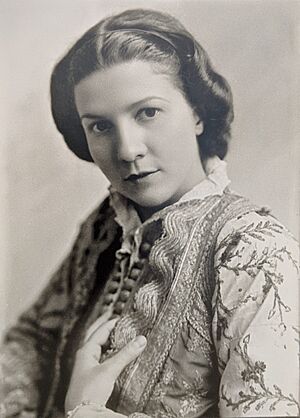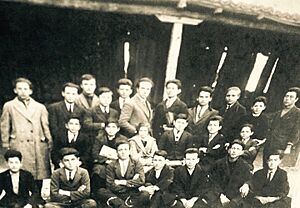Sabiha Kasimati facts for kids
Quick facts for kids
Sabiha Kasimati
|
|
|---|---|

Sabiha Kasimati posing for the photographer Kristaq Sotiri in 1942
|
|
| Born | 15 September 1912 |
| Died | 26 February 1951 (aged 38) |
| Cause of death | Execution by firing squad |
| Resting place | National Martyrs Cemetery |
| Nationality | Albanian |
| Alma mater | University of Torino (Ph.D.) |
| Known for | Ichthyologist |
| Scientific career | |
| Thesis | Fauna ittica di acqua dolce d'Albania (1941) |
| Signature | |
 |
|
Sabiha Kasimati (born September 15, 1912 – died February 26, 1951) was an important Albanian scientist. She was a professor of biology and studied fish, which is called ichthyology. Many people consider her one of the first women scientists in Albania. She was arrested by the government in 1951 and sadly lost her life soon after.
Life Story
Early Life and Education
Sabiha Kasimati was born on September 15, 1912, in Edirne, which was part of the Ottoman Empire (now Turkey). Her family was well-known for being educated. Her father, Abdurrahman, was a doctor who studied medicine in Turkey. In 1927, her family moved back to Albania.
They settled in Korçë, where Sabiha started studying at the Albanian National Lyceum. This school was also known as the French Lyceum because French language and culture were very important there. One of her classmates was Enver Hoxha, who later became the leader of Albania.
In 1930, Sabiha made history by becoming the first woman to graduate from this school. She was very good at languages, especially French. After graduating, she worked as a teacher. She taught subjects like "Moral Education" and "French Language" at a girls' school. Later, she taught "Biology" at the Albanian-American school in Kavajë, which was one of her favorite subjects.
Sabiha always wanted to study more. In 1936, she received a scholarship from the Albanian government to study at the University of Turin in Italy. She studied Biological Sciences and did very well. In 1941, she earned her doctorate degree. Her special project was about the "Fish fauna of fresh water of Albania." Soon after, she returned to Albania.
Career and Fish Studies
When Sabiha returned to Albania, she became a teacher at the Women's Institute. This school was later renamed "Donika Kastrioti". While teaching, she also spent a lot of time studying fish. She focused on sea fish that live in lagoons and swamps. She collected information for a big book she planned to write called "Fishes of Albania."
For a few years, Sabiha had to stop teaching because of her health. She went to Italy for treatment and stayed there until 1945.
After World War II ended, Sabiha came back to Albania in 1947. The new communist government had just come to power. She was quickly hired as a scientific expert at the new Institute of Studies. A year later, when it became the Institute of Scientific Studies, she was named a zoologist specializing in fish. She worked hard to organize and understand all the scientific information about fish in Albania.
Sabiha wrote an important article in 1948 called "Problems of fish and fisheries in our country." In this article, she carefully described all the different types of fish in Albania. She also talked about how to raise and grow certain fish species, like carp and koran. She explained that Albania has perfect natural conditions for many fish, with rich rivers and seas. She mentioned that the sea currents bring a lot of tiny plants and animals (called plankton) that fish love to eat. She also noted that the seabed was good for fish because it had sand and mud where aquatic plants and small creatures lived.
According to her studies, many high-quality fish like Sturgeon and Eel were found in these areas. She even mentioned that eels could travel over 300 kilometers to places like the Maliqi swamp. Sabiha also suggested that the government could make money from fishing if they used modern methods and equipment. She noticed that some valuable fish were being caught too much, which could harm the fish population. She believed that modern fishing needed ways to keep fish alive and facilities to store and process fish products.
In 1949, Sabiha went on a long trip to different parts of Albania to study fish in the rivers and lakes. She wanted to check her earlier findings. After this trip, she was able to describe all the different types of fish found in Albania. By mid-1950, she finished her book, "Fishes of Albania," which was about 200 pages long. It described 257 species of fish. However, just as her book was about to be printed, Sabiha was arrested.
Lasting Impact
Sadly, Sabiha Kasimati's important book, "Fishes of Albania," was published in 1955 but not under her name. Instead, it was published under the names of a Russian scientist and two Albanian researchers.
Sabiha Kasimati also had the idea to create a National Museum of Science in Albania. In 2018, it was announced that this museum would be named after her. A special part of the museum will tell her life story and remember her contributions.
See also
- Sevasti Qiriazi
- Parashqevi Qiriazi
- Fatbardha Gega
- Urani Rumbo
- Ollga Plumbi


